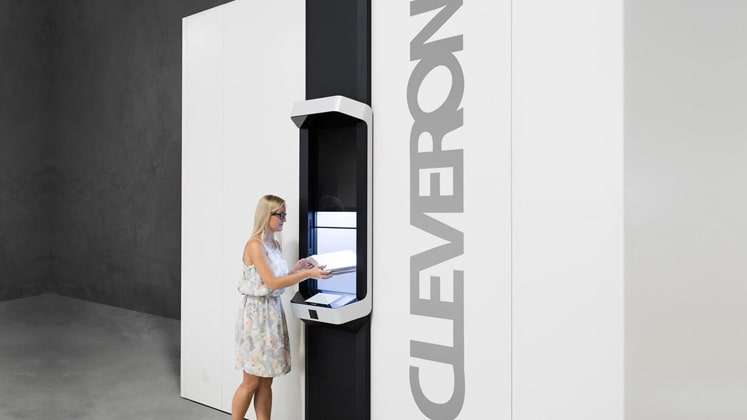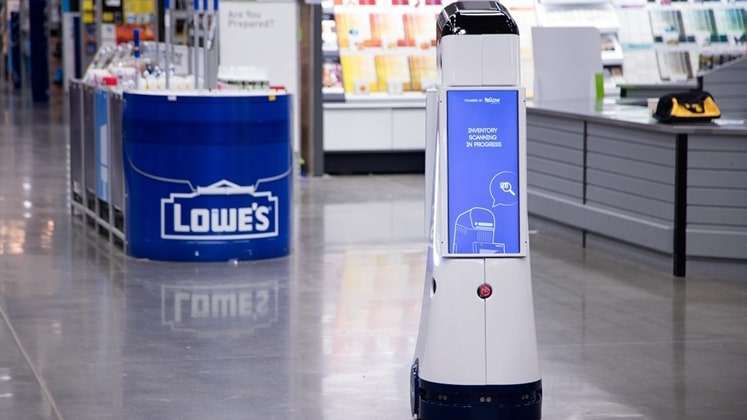
AI Robots are set to revolutionise the retail industry in the coming future. These robots will not only be responsible for handling the physical task but will also be managing more cognitive tasks by a learning algorithm that will allow them to take decisions on humans’ behalf. Today, these robots are acting as customer representatives helping shoppers with a seamless and exciting shopping experience. In this article, we will be talking about a few of these robots being used in the retail industry.
In this age of automation and digital world, customer-facing business is battling to best meet the uncertain expectations of the customers. The AI-based robots, being used as customer representatives, are helping the customers ease out the complexities of shopping in bricks-and-mortar stores. According to a report by Tractica, customer service robots market will be worth US $ 88 million by 2020. These customer service robots are designed to interact with customers and automate a few of the basic tasks for them. They can be in humanoid and non-humanoid forms and their main value lies in labour saving, efficiency and uptime.
Most of these robots help customers in locating products in the stores or guide them around the stores. They have the ability to interact with the customers in a more effective way than the human staff. Therefore, these robots have a major potential to develop interactive marketing and re-branding strategies for the tracking and analytics of customer behaviour.
Invento Robots
MITRA : These are the humanoid robots that are developed for better customer engagement in-store. These are encapsulated with three main technologies like face recognition, conversational abilities and autonomous navigation. The robots are able to recognise customers with face recognition, identify age, gender, dominant emotion levels. They can make conversation with the customers assisting them with a better and clearer response. They can inform customers about a particular product with details, discounts and offers and are capable of easily navigating around the store.
Recently the company unveiled MITRA 3, the brother of MITRA Robot. MITRA 3 humanoids are built for a more interpersonal engaging experience of the customers. These robots, unlike MITRA, are integrated with the eyes and can also imitate eye movements and human gestures.These robots are more flexible as they have three degrees of freedom (shoulder, elbow and finger movements), thus allowing them to welcome guests with ‘Namaste’. They also come with the advantage of seamless autonomous movement and obstacle detection along with speech synthesis in regional Asian languages like Hindi, Tamil and Sinhalese. “Customer engagement is awful and companies cannot afford human service employees any more. This leaves one with the options of either no engagement or a poor kiosk. We want to provide a sophisticated, fun user experience to people visiting offices, malls and airports,” says Balaji Viswanathan, CEO of Invento Robotics .
Few of the customers for MITRA include Suzuki, Smartworks, HDFC Bank, Accenture, PVR Cinemas and Airports Authority of India. The company conducted a pilot of these MITRA robots to automate check-ins and customer support for the travellers.
Spod : Similar to MITRA, these are non-humanoid Artificial Intelligence-enabled robotics shopping assistants that will assist customers with their in-store shopping decisions. The box-shaped robot mounted on a basket can easily detect faces, greet people, take inputs and navigate itself. Still under the development phase, the robot, by scanning the customers’ faces, detects if they have visited earlier and also detects their gender. These robots can make conversation with the customers assisting them to the right shelf and with product information including details of the products, discounts and offers from the spod tablet. Spod is also capable of providing remote assistance to the customers by connecting them to the experts via a video call. “The robot’s development began in response to retail markets’ needs for a device that can improve the shopping experience of customers. For retailers, it’s about driving sales. For brands, it’s about giving out more information about the product. E-commerce players want this to be used at the back-end at their inventories, while large malls want it at the front-end, guiding customers in stores,” said Balaji.
SoftBank Robots
Pepper robots: Considered as a type of SoftBank robots, pepper robots are humanoid robots which can recognise faces and basic human emotions. The robots equipped with touchscreen are able to make conversation with the customers. The major functionality that they deliver is to welcome, inform and guide visitors in an innovative way. They have 20 degrees of freedom for the most natural and expressive movements with over 15 languages of speech recognition and dialogue delivery. They can easily navigate around the store and area to assist the customers with the desired results. The implementation of these robots can be seen at Ave, a custom print apparel shop in the USA which saw an increase of footfall in the store by increasing outlet awareness, attracting new shoppers, explaining new aspects of the store and generating sales.
NAO is another humanoid robot by the company whose major application lies in education, research and healthcare. These are bipedal robots having height of 58 cms and pleasantly rounded features. Having 25 degrees of freedom enables them to move and adapt to the environment besides their additional features of speech recognition and dialogue in up to 20 different languages. The two 2D cameras help them identify shapes, images and people. In education and research, the STEAM education assistance programme acts as a teaching assistant and can easily deploy customised lessons to students and promote positive behaviour, finally to follow and monitor their progress. For health assistance, NAO assists patients in self-diagnosis and supports staff in health trending and monitoring. They are also the platform for telemedicine and the hub of information distribution (alert, notifications, fall & sound detection, etc.)
Cleveron Automatic Click and Collect
Cleveron is a leading click-and-collect pick-up automation, solution provider. The technology by the company helps retailers in providing an automated self-pick-up point for all the online orders. The machines can be installed inside the store, where the customers can come, scan the QR code or enter the code to receive their order that was purchased online. The machine is capable of processing the code and delivering the desired order to the customer without any human intervention. The hassle in the BOPIS (Buy online pick up in-store) concept, of waiting for the order to be prepared, having to contact the staff executive, is all removed with the Cleveron machines. “The ultimate goal of Cleveron’s parcel robots is to save time for the consumers. Shopping online is a faster and convenient alternative to shopping in a physical store. But the time you saved will disappear when your parcel arrives – you need to either queue at the store’s service desk or wait at home for the courier which may arrive with your parcel somewhere between 5 and 9 pm. The average online order pick-up time in the store is over 15 minutes. With Cleveron 401 and Cleveron 402, which act as automated in-store self-service pick-up points, the customers receive their orders in less than 1 minute. You just won yourself 15 extra minutes! Cleveron’s robots make shopping online and collecting orders in a physical store a positive consumer experience, which in turn increases footfall, revenue and drives growth for the company,” said Arno Kütt, Founder and Chairman of the Board, Cleveron .
He further explained, “Here is a simple calculation: An average parcel pick-up in the store is over 15 minutes. If you make one pick-up a week, in one year (52 weeks), you will spend 13 hours queuing in the store. With Cleveron 401, the pick-up is under a minute. Even if we round it up to a minute, in one year, you will spend 52 minutes on picking up your online orders from the store.”
Lowe Innovation Labs

LoweBot is a 5-feet-tall robot shopping assistant that helps the customers in the retail stores exactly like a customer representative. Encapsulated with 3D scanners, these robots can detect people entering the store. They understand and speak 7 different languages and customers can ask them about any particular product in the store. Using smart laser sensors, these robots guide them directly to the product. Along the way, these also display location-based offers and smart recommendations on their rear-facing display panel. Moreover, these also travel on the shopfloor, scanning the shelves and sending inventory updates to the store associates. They are also capable of identifying the shopping patterns at the location, so that the retailer can not only resupply its shelves but also get more understanding of which merchandise moves more quickly, and during which days of the week or seasons.
Amazon
Amazon Drone
Amazon Prime air is designed to make deliveries within promised 30 minutes. This intends to reduce cost, speed up the delivery process and remove the most expensive part of the delivery systems, that is the humans. The drone has a maximum range of 15 miles (24 km) and can deliver packages under 5 pounds (2.27 kg) in less than 30 minutes. The package is placed in a compartment that is surrounded by a protective shell as well as the motor guard, ensuring safe transport of any package. These drones are set to revolutionise the customer’s delivery experience while ensuring a 30-minute delivery, eliminating the number of days that are involved in waiting for the packet to deliver. Not just this, customers will also have a seamless delivery experience without any human intervention.
Technology is disrupting retail and so retailers need to gear up. Many of the countries have already experienced and interacted with these robots. It is not very far when these technologies will take over the current retail formats. These robots can be very useful for the retailers, as these are new innovations and customers are more curious to experience them and see them in action. These can keep track of inventory while assisting the customers on the shopfloor. Many of the customers often complain about bad experience because of the impolite behaviour of the staff members. The introduction of these robots will eliminate any interaction with the humans which otherwise creates such situations, thus affecting the brand name. However, with regard to their implementation and commercial availability of technological employment, safety in human–robot interaction remains a big point for consideration of both businesses and the Government. But the challenges have been taken care of and sooner we will see an all-new face of retail experience.

Leave a Reply